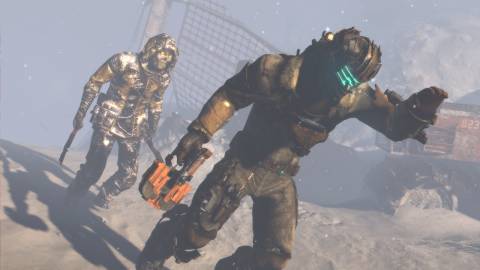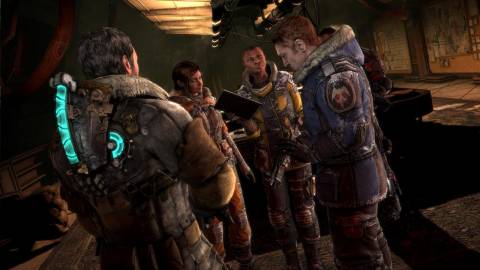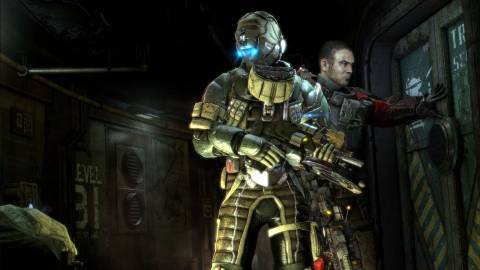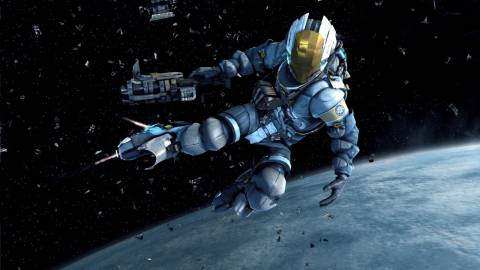
Dead Space 3 isn't just trying to be more Dead Space. With an elaborate weapon-crafting system, a campaign designed around two-player co-op, and a nonlinear structure that accommodates a wealth of optional side content, you can't accuse Visceral Games of lazily pumping out more of the same. The game's first few hours set it up as an interesting and worthy sequel built around the series' fantastic signature combat, but the deeper you get, the more Dead Space 3's repetitive levels and enemy encounters, shoddy storytelling, and general lack of refinement start to wear on you. This final chapter in the trilogy certainly gives you your money's worth in necromorphs waiting to be dismembered, but the overall quality of the game just doesn't feel equal to the high standard set by its excellent predecessors.
From the first minute, the game rushes a bit hastily into the business of closing out the Dead Space storyline with finality. Earth's government is all but destroyed, and the fanatical Unitologist group is running amok, terrorizing mankind's last settlements by activating Markers and creating necromorphs all over the place. Meanwhile, Isaac Clarke is off shirking his responsibility as The One Guy Who Can Stop All This by drinking himself stupid in a dingy apartment, until a couple of meatheaded soldier types (one of whom awkwardly becomes your co-op buddy) show up to forcibly drag him into saving the human race. After a most ill-conceived opening chapter that has you running through an exploding city and getting into firefights with human soldiers, things start looking up, and the game assumes a brisk, entertaining pace for a few hours as you move into a stint on an ancient flotilla of derelict battleships, in orbit around an uncharted planet that bears profound significance to the Marker epidemic.

While you're out there in space, picking your way through the haunted corridors of those warships, it's easy to remember what's great about Dead Space. The combat is as satisfying and brutal as ever, there's a decent bit of mood and a good number of effective jump scares, and you get to do some amazing spacewalks around the exterior of the ships, using your kinetic engineering powers to put equipment back together. And after a few hours spent reactivating generators and repairing shuttles and investigating the fate of the crew, the robustness of the new crafting feature starts to come into focus. You're limited to two weapons at a time, down from the previous games' four, but the crafting makes up for that by letting you tweak and combine massive amounts of functionality into a single weapon slot. The crafting rests on a resource system that initially feels too complex for its own good; you'll need some time before you can tell your transducers from your semiconductors from your somatic gel. As you're absorbing all this, it's easy to feel disgusted at the option to skip the effort and just buy those resources direct from EA, and by the scavenging robots you can deploy to bring back materials in bulk, provided you're willing to wait for a 10-minute timer to tick down. Or five minutes, if you're willing to buy a $5 DLC "accelerator." But eventually it's just as easy to ignore all the DLC and microtransacted nonsense completely, since you'll be swimming in crafting resources and able to build whatever you want by the end of the game if you just stay on top of deploying the default robots. That only feels a little like busywork.
You'll also start to dig into Dead Space 3's optional side missions while you're out there in orbit, and that's another new aspect of the game that starts off looking mighty promising. There's a little service vehicle you can use to ferry yourself at will between a handful of mostly intact ships, some of which don't contain anything relevant to your next story objective, but might be emitting some signal that bears investigating. In a few cases, you can elect to put off the next story mission in favor of exploring one of those other ships, where you'll find some light story touches that help fill in a little context around the nature of the fleet and the planet below, and then invariably open a cornucopia of crafting materials at the end. Those first couple of side missions train you to assume all the subsequent ones will be worth your time, and by the point when I'd handled all of my business with the fleet and headed planetside, the game had gotten into an entertaining rhythm of alternating story missions and side quests, all driven by the sort of carrot-on-a-stick character progression that propels you to eagerly keep pushing forward.

Unfortunately, I felt like the overall quality of the game began to cool rapidly the longer I spent on that damn ice planet. For one thing, physical setting aside, Dead Space 3's visual design is just drab. Remember how wildly varied the second game's environments were, how masterfully crafted its atmosphere? The frozen mausoleum, the overrun civilian shopping district, the gothic gloom of the Unitologist church: you always had some masterfully lit new area to marvel at. This game has two modes: industrial-military interior, and snow. The repetition goes beyond visual design, as the game engages in the cardinal sin of copying and pasting the same specific rooms over and over to pad out its level design. I lost count of the number of times I fought a bunch of enemies in the exact same explosives storage room, and while the problem gets so bad in the side missions that eventually I wished I'd stopped playing them, it also bleeds into the core story areas enough that everything just starts to run together after a while. There's also far less variety and creativity in the design of the enemy encounters than I remember from the last two games; after a few hours I felt like I could predict exactly when necromorphs were going to burst out of the air ducts, and exactly which ducts they'd come out of. There aren't a lot of new enemies, and even many of the series' old enemies are barely represented, as you'll spend the vast bulk of your time fighting the same handful of fodder necromorphs over and over... and over.
Some aspects of Dead Space 3 just don't feel up to snuff from the get-go. The last two games knew that horror, tension, and gore were their bread and butter, and wisely filled their storytelling in around the edges of the those core elements without letting it get in the way. As the last game of the trilogy, this one feels way too concerned with spelling out all the answers to the Marker questions, and too often it does so with hammy dialogue, implausible character motivations, and poorly devised subplots. A corny love triangle, for instance, does absolutely nothing to enhance the best aspects of Dead Space, and the game's handling of Unitology is downright disappointing. The cultish religion used to provide a vague backdrop of lunatic conspiracy to the desperate struggle with the Markers, but it's now been reduced to a sneering villain with a British accent who commands a legion of riflemen and suicide bombers. These elements stumble and crash along awkwardly as the game progresses until you arrive at the end of it all, where the final revealed truth about the whole thing struck me as completely ridiculous. The production values that support all of this are also rougher than I've come to expect from this series. Character animations in cutscenes sometimes look a bit robotic and stilted, for example, and three times I had to revert to a checkpoint to fix an audio bug that completely garbled all of the dialogue. There are parts of this game where the art and level design come together to produce scenes that are absolutely top-notch, as good as you'll see in any game, but the presence of those outstanding moments is exactly why the bad parts are so irksome.

As something close to a Dead Space purist, I resolved from the outset to play this game by myself until I finished it, but even taken as a pure single-player game, the cooperative earmarks are all over this campaign. You're constantly running into reminders that these levels, minigames, and action set pieces were designed for two people, since there's always two of everything everywhere you look. And Carver, the second player character, has a way of popping up in the story at some ridiculous times that both strain plausibility and also remind you that Dead Space was a lot cooler when it was just Isaac Clarke against the horde, not Isaac and some guy up on a ledge shouting at you about where to shoot the boss. Taken purely as a single-player game, Dead Space 3 enacts a ridiculous change in Carver's loyalties about halfway through the game, though if you play the three cooperative-only side missions, you do get some decent context about the guy's motivations, and some mildly interesting hallucination sequences to boot. It's a shame that content is locked behind a two-player requirement, though, and while you'll probably enjoy the option to play through the game with a friend if you like cooperative shooters, having another person there just serves to fully obliterate the game's already thin veneer of horror and tension.
If you're a completionist, you have to commend this game for the explicit way it details every single collectible and ancillary mode on offer. There's an exhaustively detailed progress report that tells you how many logs, collectibles, weapon parts, side missions, and other piece of minutiae you've found or finished in every chapter, and further lets you know what sort of item or set you'll unlock for completing each category. The game wisely separates your character and weapon upgrades from your story progress, making it easy to jump back into earlier chapters to look for things you missed. And there's a fantastic variety of one-off difficulty modes after you finish the game once. In addition to the standard new-game-plus mode that offers better upgrade items, there's Classic, which disables co-op and limits you to weapons from the first game, and Pure Survival, where the only way to get ammo and health items is by crafting them. Then there's Hardcore, which lets you save as much as you want but forces you to start the whole game over if you die. At all. If you do end up liking the game (and I did like it, despite its faults), these sorts of modified difficulty types are a great feature to see.
Dead Space 3 incorporates some successful new ideas into its stock horror-action formula, and some segments of the game really impressed me, but it's hard not to feel disappointed by the weaker parts of its design. I'm still glad I saw the Dead Space trilogy through to the end--and if you're invested in the series it's absolutely worth playing--but it's too bad this respectable series, which felt so exciting and fresh when it debuted just a few years ago, had to go out on a middling note.